delberg, Berlin and Strassburg, where he remained from 1894 to 1896. Returning to his native land, he settled in Cincinnati and immediately took up the practice of his profession, in which he has become pre-eminently successful. He has a large and lucrative practice, and his offices are located at No. 845 West Seventh Street. Dr. Busch is the physician of different organizations, and is a member of the Eagles, Foresters and the C. K. of O. A lifelong Democrat, Dr. Busch for many years was very active in the political affairs of his native city and State. For a period of five years he was Treasurer of the Democratic Campaign Committee of Hamilton County, and for the same length of time was a member of the Hamilton County Executive Committee. For two years Dr. Busch was Vice President of the celebrated Duckworth Club, the leading Democratic organization in Ohio. In June, 1904, Dr. Busch was joined in wedlock to Miss Luise Bering, a resident of Fayetteville. Ohio.
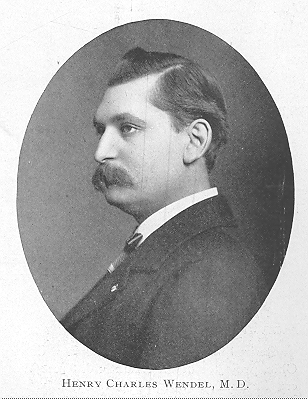
Henry Charles Wendel, M. D., A prominent physician and surgeon of Cin cinnati, Ohio, was born on the 4th of March, 1869, at St. Leon, Dearborn County, Indiana. His father, a farmer, was a native of Hessen, Germany, and emigrated to this country in 1851. Dr. Wendel was raised on the farm, and followed the same routine of labor that is given to all farm boys, thereby acquiring a rugged constitution and a splendid training, which in later years has been of incalculable value to him. His education was obtained in the public schools of Franklin County, and at the Miami Medical College, at Cincinnati, from which institution of science he graduated in 1893, with the degree of M.D. Immediately after his graduation he started the-practice of his chosen profession, in which he has been eminently successful, and by which he has gained a splendid reputation and an immense practice. Dr. Wendel is. a man of affable manners, gentle in disposition, lovable by nature, broad in sympathy and thoroughly conversant with all the details of his profession. He is a, member of all the principal medical bodies of the city, such as 'Cincinnati Academy of Medicine, the American Medical Association and the Ohio State Medical Society. Socially, Dr. Wendel is a member of the leading fraternal orders. He belongs to the different branches of Masonry, the Tribe of Ben Hur, Elks, A. O. U. W., K. of P. and I. O. O. F., and a number of social clubs and societies. He is the official physician of many insurance companies and fraternal organizations. He is a married man, and has his office and residence at No. 519 McMicken Avenue, Cincinnati, Ohio.
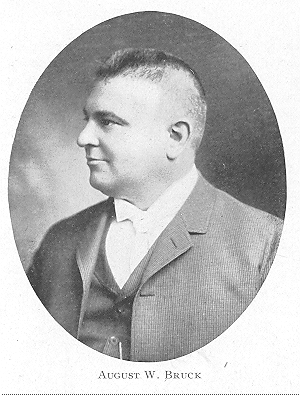
August W. Bruck, A leading lawyer of Cincinnati, was born in Milwaukee, Wisconsin, on the 8th of October, 1860, and is a son of Nicholas and Christina (Walter) Bruck. His: father was born in Bavaria, Germany, and his mother was a native of Baden, Germany ; both came to
- 625 -
America with their respective parents, locating near Milwaukee, Wisconsin. There they were married, and, in 1862, moved to Cincinnati, where. Mr. Bruck was employed in the City Waterworks for many years. August W. Bruck attended the public schools and Entrup's Academy, after which he learned type-setting. He was employed for a time by the Cincinnati Star, and later by the Cincinnati Enquirer. While holding cases on the latter paper he began the study of the law, later entered the Cincinnati Law School, and was graduated with the class of 1885. He then began the practice of his profession with ex-Judge T. A. O'Connor, with whom he continued until the latter's death. He was then associated with Hon. John A. Caldwell until the latter's election to the bench of the Common Pleas Court. Mr. Bruck was identified actively in two campaigns with the Labor party, in the first as a candidate for a seat on the Superior Court Bench, and in the second for a Probate Judgeship. With these exceptions, his political affiliations have always been Democratic. He was for a period of four years title examiner for the B. of A. Fraternally, he is a Mason and an Odd Fellow. For several years he was an officer of Typographical Union, No. 3. Mr. Bruck is married, the father of a boy, and resides with his family on Dayton Street, Cincinnati, Ohio. His offices are located in the Commercial Tribune Building, that city.
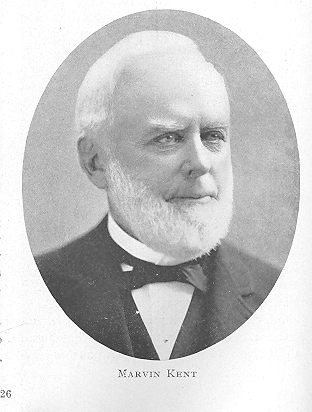
Marvin Kent, Retired capitalist of Kent, Portage County, Ohio, projector of the Atlantic & Great Western Railroad, now forming the four western divisions of the Erie Railroad, from Salamanca, New York, to Dayton, Ohio, and ex-President of the Ohio portion of said railroad, was born in Ravenna, Portage County, on the 21st of September, 1816, a son of Zenas and Pamelia Lewis Kent, both of Connecticut birth and of Revolutionary descent, the father of each having borne arms in the struggle for American independence. Mr. Kent passed his early years in his father's store, and in attendance at Tallmadge Academy and at Claridon Academy. In his nineteenth year he was dispatched to Philadelphia and New York to purchase a stock of spring goods for his father,
- 626 -
with instructions to rely on his own judgment as to his investments, and the sagacity he displayed on this mission was very gratifying to his parents. The year after attaining his majority he was admitted into partnership with his father at Franklin Mills, now Kent, but precarious health caused him early to relinquish his business. He then assumed the management of the tannery built by his father for John Brown, of Ossawattomie fame, and while thus engaged married Miss Maria Stewart, daughter of colonel William Stewart. In 1844 he resumed mercantile pursuits, and at the same time became largely interested in the manufacture of flour, continuing in the latter for nearly twenty consecutive years. In 1850, in connection with others, he erected and put into successful operation the extensive window glass factory at Franklin Mills, and at about the same time entered upon the most important enterprise of his useful life, that which has secured for him a reputation, co-extensive with the inauguration and completion of a great public transportation route, between the East and West, he devising, projecting and drafting the charter for the incorporation of the Atlantic & Great Western Railroad, designed to connect the Erie with the Ohio & Mississippi Railroad, all of which railroads were of six-foot gauge, .thus form- ing a grand trunk line with a six-foot uniform gauge throughout from. New York to St. Louis. In 1851 the necessary legislation was secured, but in order to secure the charter he was obliged to subscribe for the full amount of stock required by law for the organization of the company, as well as to indemnify some of the first Board of Directors for the payment of one share subscribed by each to render them eligible for election, which furnishes a significant illustration of the want of faith in the success of an undertaking of that magnitude at they time. The organization of the new company was completed, and Mr. Kent was made its first President. That position he filled with a success characteristic of his great ability and energy until the final completion of the road, in 1864, save an interval of about three years. On the 4th of July, 1853, he broke the ground for the new railroad by removing the shovelful of earth, at Kent, Ohio. Eleven years later, on the 21st of June, 1864, he had the proud satisfaction of looking back over many years of unremitting labor and anxiety, at last crowned with success, when he drove home the last spike in the last rail, at Dayton, Ohio. At or about the same time the Cincinnati, Hamilton & Dayton Railroad Company had covered its track with iron rails on both sides from Dayton to Cincinnati, thus connecting the Ohio & Mississippi Railroad with their six-foot gauge. The first continental line from New York to St. Louis was completed. His life's work done, Mr. Kent retired from active bUsiness to the enjoyment of a private life. In 1865, his father died, and he became his successor as President of the Kent National Bank, which position he has held ever since. In the fall of 1875 he was elected State Senator from the Twenty-sixth District of Ohio, and he served his constituents for two years with credit and ability. At the conclusion of his term of office, Mr. Kent declined a renomination. Mr. Kent is a man of varied experience, and his life's work is a proof of his business qualifications. He was equally capable as an engineer or as a financial manager conducting a great institution. Mr. Kent always had remarkable tenacity of purpose, and once resolved as to the value of an enterprise, no ordinary obstacle could prevent him from carrying it out. He is a man of liberal ,views and generous impulses, and has in various ways aided in advancing the material welfare of those among whom he lives. He has been a generous promoter of nearly every business enterprise in the city of Kent. the city which bears his name. There are enduring monuments of his public spirit on every hand in his community, such as public and private edifices, business blocks, mills and factories, and about them all there is an evidence of permanency, durability, exactness in details, and adaptability to the uses for which they were designed. To the union of Mr. and Mrs. Marvin
- 627 -
Kent were born two children—Henry Lewis, who died on the 21st of April, 1873, and William Stewart, who is Vice President of the Kent National Bank.
Robert Colwell Heflebower, M. D., An oculist and aurist of reputation, at Cincinnati, Ohio, was born on the 3d of July, 1865, in Urbana, Ohio. The parents of Dr. Heflebower were Daniel Philip Heflebower and Fannie Colwell, both of whom were natives of Ohio. His father's ancestors came from Baden, Germany, in 1708, and settled in Virginia, while his mother's progenitors emigrated from the north of Ireland in 1731. His ancestors on both sides have taken an active part in the affairs of their country, and there has not been a war since the Declaration of Independence when at least one member of his family did not participate. Dr. Heflebower's education was obtained in the public schools of Urbana, the Miami Medical College of Cincinnati, and at the famous Universities of Berlin and Heidelberg. He graduated from Urbana High School in 1883 and from the Miami Medical College in 1889, with the degree of M. D. After finishing his studies, Dr. Heflebower settled in Cincinnati, where he became engaged in the practice of his profession, as an oculist and aurist. His offices are located at the Lancaster Building, on West Seventh Street, that city. In 1892 Dr. Heflebower was united in marriage in Copenhagen, Denmark, to Helga, the daughter of Major General von Beissenberg, of the.Danish army. Two children have been born to them, a daughter and son.
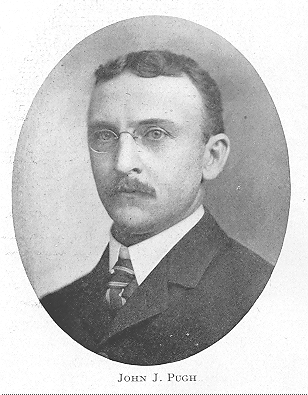
John J. Pugh, Librarian of the Columbus Public Library, recognized as one of the best read men in the State of Ohio, and an authority on all bibliographical questions, was born on the 29th of February, 1864, in the city of Columbus, Ohio. His parents were Richard and Elizabeth Jones Pugh, both of whom came originally from Wales, which country has furnished some of the best blood in the United States. They came to the Capital City during the month of May, 1854. Mr. John J. Pugh received a very careful education in the public schools of his native city, and the Central High School, graduating from there with the class of 1881. after having taken a scientific and literary course. After his graduation he attended the Normal School for one year under Professor Alfred H. Welsh, taking another literary course, and subsequently for two years madea special study of English and literary subjects. From 1881 to 1897, a continuous period of sixteen years, he was the Assistant Librarian of the Columbus City Library, holding the place of First Assistant since 1885. He occupies his present position since 1897, and during his incumbency the affairs of that institution have been carefully protected. The growth of this library has been remarkable under his administration. Owing to the initiative of Mr. Pugh, the city of Columbus will have one of the best and most modern libraries in the
- 628 -
State of Ohio, the building costing not less than $200,000, with ample space to accommodate 200,000 volumes. The money necessary for the erection of this magnificent edifice has been donated by that great patron of public libraries, Andrew Carnegie, who made his bequest through the efforts of Mr. John J. Pugh. In political affairs, Mr. Pugh is a lifelong Republican, and takes a keen interest in the affairs of his party. Socially, he is a Mason of high standing, a thirty-second-degree Scottish Rite Mason, a member of the I. O. O. F., of which he is Past Grand Master, and Past Chief Patriarch of Junior Encampment, No. 276. He also belongs to the Columbus Republican Glee Club, with which he has been identified since 1881. He is active among the Junior Hussars, and is attached to the military staff of the Grand Sire, I. O. O. F. He holds a life commission on the staff of the Patriarch Militants. Mr. Pugh has been President of the Columbus Opera Club for a perid of two years, a well-known organization which on several occasions presented complete operas. On the 22d of August, 1888, he was united in marriage to Miss Catherine Fornhoff, a graduate from the Columbus High School with the class of 1885. His wife died on the 5th of March, 1900, leaving three children, Elizabeth Louise, Catherine Loving and Mary Ellen Pugh. Mr. Pugh's residence is located at No. 208 North Washington Avenue, Columbus, Ohio.

Dr. John Byers Wilson, Was born of Scotch-Irish parentage, in West Union, Adams County, Ohio, on the 6th of January, 1857. His father, David Finley Wilson, was a man of limited education, but was well informed, possessed a remarkable memory and some poetical talent. His mother, Evelyn Campbell, was a direct descendant of the famous Clan Campbell, her great-grandfather, Matthew Campbell, being the fifth son of the second Duke of Argyle. Becoming a Dissenter, he was alienated from his family, and came to America, first settling in Virginia, and later removing to Lewiston, now Mays. ville, Kentucky, the farthest settlement west at that time on the Ohio River. Here he married a member of the Shelby family of Kentucky, and soon after built a large stone house on the opposite bank, which served as both fortress and inn. The village which sprang up around him was named Aberdeen, after the city of the same name in Scotland. Some years later, in company with a number of settlers, he descended the Ohio on a raft, and, landing at a point opposite the Licking, erected the first house built on the present site of Cincinnati
Dr. Wilson's youth was that of the ordinary village lad. He attended the village school, and labored on the farm until his sixteenth year, when he started out for himself as teacher of a country school. With the exception of one year, spent at the National Normal University at Lebanon, Ohio, he pursued this occupation for the next eight years, teaching in
- 629 -
Adams, Brown and Ross Counties. For the next three years he was employed as salesman and collector for a leading publishing house, at the end of which time he settled in Cincinnati, and began the study of medicine, at which he graduated in 1889. During his vacations he gained further experience as a hotel clerk and newspaper reporter and writer.
Soon after his graduation he received the appointment of Assistant Health Officer, or ward physician to the worthy poor, and immediately located in Cincinnati. Here, for the next three years, he labored zealously at his profession, fighting disease in its worst forms, and under the most unfavorable hygienic circumstances. Here, too, through a financial crisis, he came to know the virtues and vices, the patience and complainings, the wants and woes, the humanities and inhumanities, the sorrows and afflictions of the destitute poor, and all the disease and degeneration bred from the evils of poverty. These observations led him to the study of the social and economic conditions affecting society, upon which subjects he occasionally lectures, and frequently contributes vigorous articles for the press. All these varied avocations and experiences, of country, village and city life, of farm and school and travel ; of educational, professional and literary pursuits have tended to make him a man of broad and liberal ideas and strong convictions. Fearlessly he attacks all forms of society, which to him appears to perpetuate ignorance, superstition and social injustice and wrong. He believes that it is to the interests of, and the duty of government to see to it, that every child shall have the right to be born right, and that, unhampered by superstition or other prejudicial influence, it shall be left free to develop, intelligently, the natural functions of both body and brain.
Dr. Wilson early became a convert to the teachings of Paine and Ingersoll, and later becaine an ardent disciple of Darwin, Spencer and Haeckel. As an advocate of the scientific and sociological principles taught by these and other reformers, Dr:Wilson has been a leading spirit in this country, and among that vast and ever-growing class, calling themselves Liberals or Freethinkers, he has won a National reputation. In 1899, at its congress in Cincinnati, he was elected President of "The American Secular Union." Resigning the following year, he organized 'The American Freethought Association'," of which he is now President, and which further honored him by making him its unanimous choice as American delegate to the great International Freethought Congress held in Rome, Italy, September, 1904. As . this congress was the first of its kind ever held in Rome, it marked an epoch in the history of the world's progress, not second to that of the Reformation. Here, more than five thousand delegates, from all parts of the world, assembled in the "College of Rome," the greatest temple of learning in Italy, once a Jesuit college, but now controlled by the government, the congress was welcomed by a leading representative of the Italian government, and other unusual courtesies shown it.
Dr. Wilson looks upon it as one of the greatest honors that could come to him, to have been American delegate to this congress, which was first openly to proclaim free thought, free speech, free press, and complete separation of Church and State, in the midst of an opposition which for thousands of years has been most active and influential in opposing these civilizing principles. Dr. Wilson was placed on one of the most important committees, and here became associated with many of the leading sociologists and scientific mind of the- world, among them Professor Ernst Haeckel, of Germany ; Professor Berthelot, *of France ; Professor Mandsley, of England; Professor Hector Denis, of Belgium ; Professor Salmeron, of Spain ; Professors Sergi, Ghisleri and Lombroso, of Italy ; Bjorsen Bjorsen, of Sweden, and others whose fame is as wide as civilization.
Dr. Wilson has just published a book giving full details of this congress, and a history of the rise and progress of Freethought. Besides his interest in this direction and the
- 630 -
active duties of his profession, Dr. Wilson has found time to court the muse. He has col lected his poems into a volume, which is now in the hands of the publisher. His verse is chiefly descriptive of Nature and farm life, and competent -critics rank him high among authors who have written along these lines. The following beautifully descriptive piece is a fair sample of his composition, and touches a warm spot in the heart of every one whose youth has been associated with the country and farm :
Bob White
1
The city's heat grows stifling—
In fev'rish dreams I stray,
Recalling far-off June-times-
The locust shade at noon-times,
And sportive breezes trifling
With blossoms in their play ;
And bees the honey rifling
From blossoms all the day.
2
Once more I lie and listen
To Nature's music sweet;
Once more my old companions
Of woods and fields I meet ;
I hear their .myriad voices,
But clear above them all;
And warmest in its welcome,
Is Bob White's cheery call.
3
And "Bob-Bob White !" 's his greeting,
As in the olden time,
When I turned the stubble over,
When I raked the hay and clover,
In the summers all too fleeting—
In summer's flow'ry prime,
While his song he kept repeating,
Which now inspires my rhyme,
4
Which oft aroused the brute inbred,
And with a sportsman's glow,
I'd sight the handle of my rake,
And-vicious aim upon him take,
And wish it were a gun instead,
To fire and lay him low ;
Just to lift the feathers from his head,
My sportive skill to show.
5
Ah! the thought of wilful murder
Brands with shame my fev'red brow ;
I would pay you well, dear Robert,
Could I hear your music now ;
Your love-call to your listn'ing mate,
Brooding in her secret nest,
Would echo loud the fond heart-throbs,
For the one I love the best.
6
And bring again those summer days,
And glorious, golden hours,
When, boy and girl, we sought your haunts,
Together plucking flowers ;
And tiptoe on an ancient stump,
In the tall wheat, hid from view,
You loudly called "Bob White !" to us,
Which I whistled back to you.
7
Ah ! my heart is sick with longing—
Vainly longing for your tune ;
For the varied scenes of childhood,
For the meadow, dale and wildwood,
And the thousand charms belonging
To the month of merry June ;
Ah! the mem'ries that come thronging
With thoughts of youth's bright June:
- 631 -
Dr. Wilson is a member of the Academy of Medicine, of Cincinnati, the Benevolent and Protective Order of Elks, Knights of Pythias, Knights of the Maccabees, Independent Order of Foresters, Tribe of Ben Hur, and Medical Examiner for a number of old line and fraternal insurance companies.
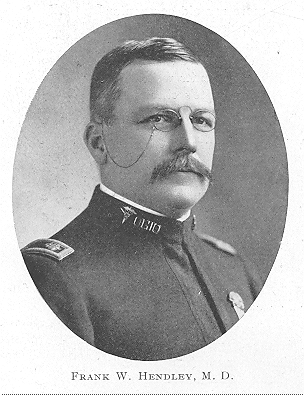
Frank W. Hendley, M. D., Is of English descent, born in Cincinnati in the year 1860. After attending the public schools and Hughes High School of his native city, he spent a few years in mercantile life, after which he took up the study of medieine, entering the Medical College of Ohio, now the Medical Department of the University of Cincinnati, graduating in 1885. In 1884 Dr. Hendley was an, interne in the Cincinnati Hospital, and in the year of his graduation was house physician in that institution, after which he became engaged in the active practice of his profession until 1892, when he was appointed Superintendent of the Cincinnati Hospital and continued as such. a little over four years. Upon retiring from the Superintendency of the Cincinnati Hospital, Dr. Hendlev resumed the practice of his profession at Walnut Hills, Cincinnati. He 'has been prom- inently connected with the National Guard of Ohio, having served five years as Assistant Surgeon and four years in the First Regiment of Infantry. During the War with Spain, he served as Major and surgeon of the First Ohio Volunteer Infantry, from the 25th of April, 1898, until the regiment was mustered out, on the 25th of October, in the same year. By order of the Secretary of War, he was con- . tinued .in the service, his duties being that of physical examiner of Ohio troops at Columbus, Ohio. This position he held until the 21st of January, 1899. During August and part of September, 1898, Dr. Hendley was chief surgeon of the combined Second and. Third Division, Fourth Army Corps, at Fernandina, .Florida, on The staff of .Major General Louis H. Carpenter. In the fall of 1899 he was elected. as an Independent Republican, a Representative from Hamilton County to the lower House of. the Seventy-fourth General Assembly on the Fusion. ticket, receiving the third highest majority of the ten Representatives elected from his county. Upon the reorganization of the National Guards of Ohio, in 1901, Dr. Hendley resumed his affiliation with that body. Socially, he is a member of the Masonic fraternity, a Knight Templar and an officer in, the Scottish Rite branches of Masonry. He is also a member of the American Medical Association, the Ohio State Medical Society, the Academy of Medicine of Cincinnati, the Association of Military Surgeons of the United States and the Military Order of Foreign Wars.
- 632 -
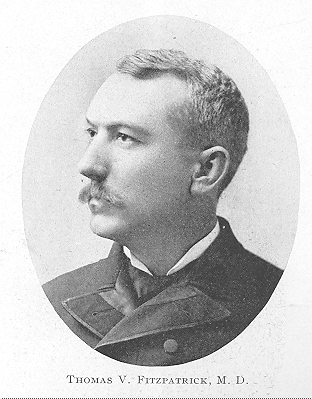
Thomas V. Fitzpatrick, M. D., One of the most eminent laryngologists and aurists in this country, was born on the 9th of April, 1855, at Nicholasville, Clerinont County, Ohio. He is the son of Solomon and Zerilda (Vanhook) Fitzpatrick, both of whom were natives of Kentucky, where the family has resided for many generations. He received his education in the public schools of his home county, and coming to Cincinnati in 1871, completed his education in that city, passing from an unfinished course at Hughes High School to the Cincinnati College .01 Medicine and Surgery, from which institution he graduated in 1875. In 1890 he received the honorary degree of Ph.D. from Twin Valley College. He has continuously practiced his profession since 1875, first at Paragon, Indiana, one year, then at New Baltimore, Haniilton County, Ohio, from 1876 to 1887. ̊In 1888 he attended the New York Post Graduate School of Medicine, where he devoted his time exclusively to the study of laryngology and otology. After completing this course of special study, Dr. Fitzpatrick went abroad and devoted his entire time to the study of his chosen specialty among the famous medical institutions of the Old World. Returning to the United States, he commenced practice in Cincinnati, where his talents were soon appreciated, and where he established a, flourishing practice. .In 1888 he was appointed Professor of Laryngology, and Otology in the Cincinnati College of Medicine, which position he filled up to the closing of the college in 1892. He was Dean of Faculty for fotfr years. He is a member of the American Medical Association, American Laryngological, Phinological and Otological Association, Westein Opthalrnological Society, Pan-American Congress, Mississippi Valley Medical Association, Miami Valley Medical Association, Ohio State Medical Society, Cincinnati Academy of Medicine, and from 1890 to 1893 was Secretary of Cincinnati Academy of Medicine and also Secretary of the Ohio State Medical Society. He is a thirty-second-degree Mason. In politics, Dr. Fitzpatrick is a staunch Republican, and has twice been elected Mayor of the city of Norwood, which position he filled acceptably to his constituents and the public in general. In 1885 he married Lotta A. Wiley, daughter of John Wiley, an early pioneer of Hamilton County. She died on the 8th of October, 1893, leaving one son, E. Verne Fitzpatrick. In 1899 he was married to Florence Swing, daughter of Judge Peter F. Swing, by which union he has one son, Thomas Swing Fitzpatrick.
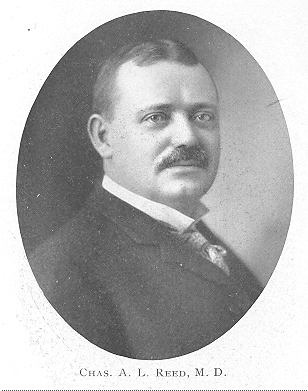
Chas, A. L. Reed, M.D., Of Cincinnati, Ohio, a physician of National reputation, is a native Indianian, born on the 9th of July, 1856, at Wolf Lake, Noble County. His father, Dr. R. C. Stockton Reed, was a well-known physician. His mother's maiden name was Nancy Clark. Dr., Charles A. L.
- 633 -
Reed obtained a careful education in the schools of his home district, after which he attended Starr's Institute at Seven Mile, Ohio. After his graduation from this well-known institute, Dr. Reed matriculated at Miami Medical College, Cincinnati, Ohio, graduating from this seat of learning with the degree of M.D. He later graduated from the Cincinnati College of Medicine and Surgery, and then took a post-graduate course in Trinity College. Dublin. Subsequently he was a student at the Spark Hill Hospital at Birmingham, under Lawson Tait, and at the Samaritan Free Hospital, London, under Bantock Thornton and Sir Spencer Wells. Dr. Reed began the practice of his profession as a district physician in the old Fifth Ward of Cincinnati, in 1875, before he had reached his twentieth year. Later he practiced at Fidelity, Illinois, and Hamilton, Ohio. In 1887 Dr. Reed returned to Cincinnati, where he has resided and practiced ever since. To-day Dr. Reed is recognized as one of the most able physicians of the Oueen City, and he stands high in the esteem of his clients and his fellow practitioners. Dr. Reed's reputation is only confined by the limits of the United States. He is a member and an ex-President of the American Medical Association, a member of the Ohio State Medical Association and of the Cincinnati Academy of Medicine, of the American Association of Obstetricians and Gynecologists, and of the Southern Surgical and Gynecological AssOciatiori, a Fellow of the British Gynecological .Association, and an Honorary Fellow in the Medical Society of the State of New York. Dr. Reed has always been widely interested in the affairs of the University of Cincinnati and the medical institutions of his home city. For many years he was a member of the Board of Trustees of the Cincinnati University, and he has been untiring in his efforts to unite all of the various higher educational institutions of Cincinnati—medicine, law, art, etc.—under the management of the Cincinnati University. In the years of 1876-1877 he was Professor of Pathology in the Cincinnati College of Medicine and Surgery, and for many years he occupied the chair for diseases of women and abdominal surgery. He also served as Dean of the same institution. It was to Dr. Reed's initiative that the first Pan-American Medical Congress, which was held in Washington under the auspices of the United States Government in 1893, became a reality. Dr. Reed was the Secretary-General of that body. He acted as Chairman of the Section on Obstetrics and Gynecology. This congress was an association of representative physicians from all over the Western Hemisphere. Nineteen different countries and colonies were represented in that body. The transactions of that congress were published by the United States Government in volumes embracing more than two thousand pages. In recognition of. his services in conhec6on with the congress, Dr. Reed was presented with a silver salver, duly inscribed, the presentation- occurring after the adjournment of that
learned body. In January, 1905, Dr. Reed was honOred iby President Roosevelt, who
- 634 -
appointed him a member of a commission to ascertain the value of certain lands in the Panama Canal zone. Dr. Reed's offices are located in Groton Building, corner Seventh and Race Streets, Cincinnati, Ohio.
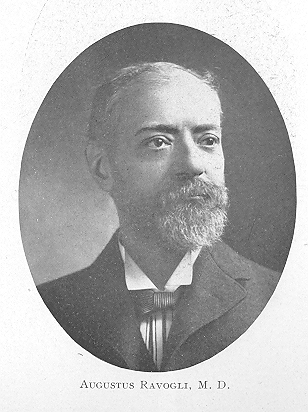
Augustus Ravogli, M. D., A prominent physician and surgeon of Cincinnati, formerly Italian Vice Consul there, was born on the 7th of February, 1851, at Rome, Italy. He was thoroughly educated in the schools of his native country in the various branches of literature, and graduated from Medical college on the ,14th of August, 1873. His first professional service was as physician on. board the steamship "Asia" for six months. He continued his studies at Rome, and after a brief preparation, entered a competitive examination for hospital honors at Rome, in which examination he received the highest rank in a class, of eighteen. His next. success was in a contest for a government prize of two years abroad, which time he employed. in the careful study of skin diseases at Vienna, Prague, Berlin, Wurzburg, Munich and other cities. After his return to Rome he served as surgeon in the Government Hospital for five years and as Assistant Professor of Skin Diseases- at the university there. In December, 1880, Dr. Ravogli decided to seek a wider field for his work and came to America, reaching the city of New York on New Year's Day, 1881. He came immediately to Cincinnati. The Doctor makes a specialty of diseases of the skin, and is recognized as an authority in this branch of his profession: Qualified by experience, education and careful scientific study of this particular line, he has won distinction in his adopted city and is widely known in other sections of the country. For some years he was clinical lecturer on this subject at the Miami Medical College, and for five years past has been professor of this branch of medical science at the Cincinnati College of Medicine and Surgery. In 1896 he was appointed to the Chair of Dermatology and Syphilology in the Medical College of Ohio. He published in 1888 a book on hygiene of the skin. Dr. Ravogli is a valued contributor to the various medical journals, and belongs to the Cincinnati Academy of Medicine, the Ohio State Medical Society, the American Medical Association, the Executive Committee of the American. Medical Congress, the American Society of Dermatology, the French Society of Dermatology at Paris, and the Italian. Society< of Dermatology at Rome. Dr. Ravogli attended the International Medical Congress, which met at Madrid in 1903, and was elected President of the Department of Dermatology. In March, 1878, Dr. Ravogli was united in marriage to Julia Schindelin., of Vienna, Atistria. Fraternally, he is a thirty-second-degree Mason. He is a member of the State Board of Medical Examiners and Registers. For a period of seventeen- years he represented Italy
- 635 -
as Vice Consul at Cincinnati, but upon the death of King Humbert he resigned. His splendid services had been recognized by that King by conferring knighthood upon Dr. Ravogli.

Howard Ayers, From 1899 to 1904 President of the University of Cincinnati, was born in 1861 in Olympia, Washington. Territory. While he was still an infant his father, a hardware merchant, moved from Olympia to Ft. Smith, Arkansas, where young Ayers received his primary and secondary education in the common schools and High School of that city. His father sent him to Michigan University, where he took a scientific course, and developed a strong taste for biology and kindred subjects. He left Ann Arbor after three years stay and went to Harvard, where he found better opportunities for biological study. He was graduated from Harvard in 1883 with the degree of Bachelor of Science, and with the highest honors of his class. While at Harvard he won the first Walker prize, offered by the Boston Society of Natural, History, and open to contestants from all parts of the world, for the best scientific memoir. After receiving his degree he went abroad and studied for two years at the Universities of Heidelberg, Strassburg and Freiberg. At Freiberg he obtained the degree of Doctor of Philosophy magnet cum laude. Subsequently he pursued his studies and work of original research at the Marine Zoological Station of Vienna University at Trieste, and at the Station Maritime of the University of Paris at Banyal-sur-Mer, France, and attended lectures at the College de France and Sarbonne. On his return to the United States he became instructor in biology at the University of Michigan for one year. The next year he was called to Harvard, where he taught for two years, both in the University proper and in Radcliffe College. In 1889 he was appointed director of the Allis Lake Laboratory of Biology at Milwaukee, succeeding C. O. Whitman, now the head of the department of biology in Chicago University. He remained for four years at the head of the Lake Laboratory, an institution founded by Mr. Allis, a wealthy gentleman of Milwaukee, for original biological research. Mr. Allis then transferred his laboratory work to. Menton, and invited Or. Ayers to take charge of it The offer was declined. In the fall of 1893 Dr. Ayers was called to take the chair of biology in the University of Missouri, at Columbia, Missouri, an institution with some sixty members of the faculty and about eleven hundred students. He reorganized the Department of Biology, and has made it one of the prominently successful departments of the University. Since his graduation at Harvard, Dr. Ayers has published many memoirs on biological and kindred subjects, in English, German and French. He is an active member of the leading scientific societies of the country and of many in Europe. For many years he has been in charge of biological research at the Marine Biological Laboratory at Wood's Hall,
- 636 -
Massachusetts. While in Europe, Dr. Ayers gave special attention to the methods of education prevailing in the German gymnasia and universities. Dr. Ayers' work at the University of Cincinnati was pre-eminently successful, but on account of difficulties with the Board of University Trustees, Dr. Ayers left the institution in the spring of 1904.
Dr. Ayers is a man of fine physique, of tremendous energy, and unwavering fixity of purpose. While at the University of Michigan and at Harvard he Was member of the University foot ball teams, and he rowed on the class crew at the latter place. After his retirement, Dr. Ayers 'became interested in a large Cincinnati industrial enterprise.
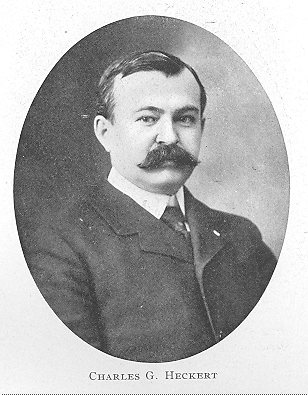
Charles G. Heckert, President of Wittenberg University, at Springfield, Ohio, was born in Northumberland, Pennsylvania, on the 22d of March, 1863. His parents were Benjamin and Sarah (Durst) Heckert, who were natives of the Keystone State. When the boy was eight years of age the family moved to Sunbury, Pennsylvania, where for many years the father was prominently identified with the commercial interests of that city. Dr. Heckert acquired his preliminary education in the public schools of Sunbury, graduating from the High School with honors at the age of fifteen. Two years were then spent in business, after which, ambitious for college training, the boy of seventeen started for Springfield, Ohio, in 1880, to enter Wittenberg College as a member of the Freshman class. Here he pursued his studies for two years, after which he engaged in teaching for a similar period. Returning to his chosen institution, he was graduated with first honors in the class of 1886. Wishing to give his life to the work of the gospel ministry, he entered upon a course in theology in the Wittenberg Theological Seminary, being graduated in 1889.
His career as a teacher began during his last year in the seminary, when he accepted a pOsition as instructor in the Wittenberg Academy. At the time he had not the thought in mind of making teaching his life work. After three years' work in the Academy, two of which were spent as Principal, he was advanced to the Chair of English and Logic in the college. This chair he occupied for ten years, resigning this in 1903 to accept the Presidency of his Alma Mater.
On the 24th of July, 1889, Dr. Heckert was united in marriage to Miss Addie R. Royer, of Lamar, Pennsylvania.
Dr. Heckert has been managing editor of the Lutheran World, one of the leading church papers of his denomination in this country. He has been Secretary and President of the Miami Synod of this State. He was for awhile a member of the Springfield' Board of Education, and has always taken a strong interest in every political movement looking to increased efficiency and purity of municipal and State government. He was for three
- 637 -
years President of the Springfield. Law. and Order League. Socially, he has been connected with the Masonic fraternity, being a thirty-second-degree Mason.
Dr. Heckert . was inaugurated President of Wittenberg College in June, 1903, since which time he has devoted himself almost exclusively to the administration of the affairs of the institution. His .class-room work is now confined solely to the Chair of Logic. He is a contributor to the leading papers and magazines of his denomination.
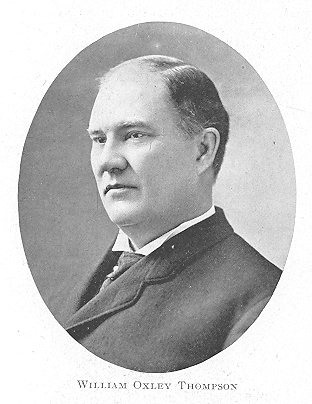
William Oxley Thompson, The great strides taken by Ohio along educational lines and the wonderful growth of the college and university idea in this commonwealth, is largely due to her controlling, forces at the head of her educational institutions. The people year by year come to set greater store on higher education, and the youth are looking more .and more to securing that which will benefit them in their adult life; but after all, the individual success of each college and university is largely controlled by the personality that directs its affairs. The Boards of Trustees manage the financial and business ends of these educational enterprises, but the popularity of the President, his thoroughness as an educator, his character, and, above all, his energy in pushing the claims of the school with which he is connected, and his ability to make good these claims, go far toward paving- the way to educational and financial success. The Ohio State University at Columbus, that most important ward of the Buckeye State, has grown and expanded. until to-day it stands among the foremost of its class in this country, and this condition of affairs is. in a great :measure due to the men who have been the dominant factors in its management and control. When the roll is called of the Presidents who have wrought well. to promote the interests of this great and beneficent institution, the name of William Oxley Thompson Will very nearly, if not quite, follOw the example set by Abou Ben Adhem, who led all the rest. In the six years that he has had it under his care, constant and convincing growth has been the watchword and result, until to-day it looms up as not only the greatest, university in Ohio, but fast approaching the standard set by historic Oxford on the tight little island. Dr. William Oxley Thompson was not born of the purple. He had to hew his own way in the world, arid he burned the midnight oil in order that he might secure an :education that has since placed him in the front rank of those whose task it is. to prepare for the realities of life. He was born on the 5th of November; 1855, at Cambridge, Ohio., the son of. David Glenn Thompson. His parents were poor in this world's goods, and his education at home was confined to the country, district and town schools. He was ambitious, however, to secure a good education, and at the age of twelve years began to support himself by working on a farm. His mother was a superior woman mentally, and from her he inherited that love for the high things
- 638 -
that afterwards marked. his adult life and made him a factor in the work of education. He graduated from Muskingum College, New Concord, Ohio, with the degree of A.B. in 1878, taught school at Lawn Ridge, Illinois, one year, to get money to complete his education, and in September, 1879, he entered Western Theological Seminary, at Allegheny, Pennsylvania, graduating therefrom in 1882, receiving the degree of A.B., in 1881, from his Alma Mater. After leaving school he entered the Presbyterian ministry, accepting a charge at Odebolt, Sac County, Iowa, in May, 1882; and remained until April, 1885, when he was called to the pastorate of the Presbyterian Church at Longmont, Colorado. In October of that year he was elected President of Longmont College, which position he filled in connection with his pastorate for four years. In 1891 he was called to Miami University, at Oxford, Ohio, beginning his work there in August of that year. Under his management the institution took on a new life and largely increased its sphere. of usefulness. In 1899 Dr. Thompson was chosen President of the Ohio State University, a position he has filled with pre-eminent success. The university and its fast increasing clientele of friends and patrons are sufficient proof of Dr. Thompson's. fitness. for his important and responsible position. On the 21st of September, 1882, at Indiana, Pennsylvania, Dr. Thompson was united in marriage to Miss Rebecca J. Allison, who died on the 15th of August, 1886 at Longmont, Colorado. One daughter, Bessie' Thompson, was the issue of that union: In October, 1887, he was wedded to Helen Starr Brown, at Longmont, and two sons, Lorin and Roger, Were born to them. Mrs. Thompson died on the 27th of, December, 1890. In June, 1894, Dr. Thompson married Estelle Clark, of Cleveland, a brilliantly educated and highly accomplished lady, who now graces his home. Dr. Thompson in all his educational career has been a:positive force for good and progress. He is broad-minded, and has a generous way of looking at things. His strong executive ability, hearty co-operation with the educational growth of the State, his sound common sense and his manly character are all strong additions to his splendid personality. He is a man of great mental and physical vigor and resistless energy, and the splendid financial aid extended to the Ohio State University by the: General Assembly is largely due to the high position he occupies in. the minds of the legislators.
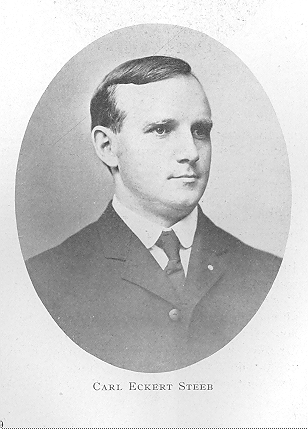
Carl Eckert Steeb, Secretary of the Ohio State University, at Columbus, was born on the ioth of November, 1874, at Medina, Ohio. His father, John Steeb, was a native of Germany and his mother a native of the Buckeye State. Mr. Steeb was carefully educated, attending the public schools of. his home district and the Medina High School, after which he entered the Ohio State University, graduating from' that institution in. 1899 with the degree of B. Ph. At the age of twenty-nine years Mr. Steeb started into his career of public usefulness, accepting a position, as an accountant in the Ohio State University. In the fall of 1904 he was elected
- 639 -
to his present position, that of Secretary of his Alma Mater. On the 17th of October, 1900, he was united in marriage to Miss Kathryn M. Davy. One daughter, Helen Anderson: Steeb, is the issue of their union. Mr. Steeb and his family are members of the Congregational Church of Medina, Ohio. Mr. Steeb is .a member of the Masonic fraternity, the Royal Arcanum, and the college fraternity, Sigma Alpha Epsilon. In political life, Mr. Steeb is a staunch Republican. His offices are located in the Administration Building of the 0. S. U., and his residence is at No. 1437 Hunter Street, Columbus, Ohio.
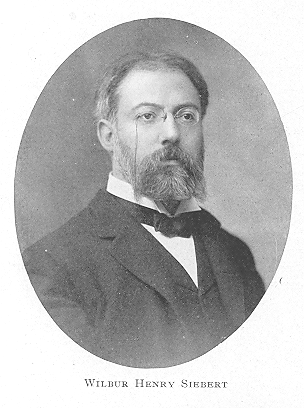
Wilbur Henry Siebert, Secretary of the Faculty of the O. S. U., was born on the 30th of August, 1866, in Columbus, OhiO, and is the son of Louis and Sarah A. Siebert. On his father's side he is of German descent; on his mother's his ancestry is Dutch and English. His paternal grandfather, Henry Lawrence Siebert, was a Lirerman patriot, who fought in the wars against Napoleon Bonaparte, and in the .early '30's favored the liberal or constitutional movement in Germany. As the period proved to be one of political reaction, however, Mr. Siebert, like many of the better class of Germans of that day, decided to emigrate to the United States, where he could be free in his political beliefs, and where also his sons, of whom. there were six, would not be called on to do military service in the cause of despotism. The Siebert family, therefore, left Frankfort-on-the-Main and came to America in 1832, settling first at Somerset, Ohio, but at length removing to Columbus on the 15th of July, 1834. Professor Siebert's maternal grandfather was Henry Van De Water, a member in the fourth generation of the Dutch family of that name that settled at New York. His maternal grandmother was Sarah Brand Van De Water, who was of English stock, and a native of New Jersey. This branch of the Van De Waters removed from New York City to Columbus in 1834 by way of the Erie and Ohio Canals.
Mr. Siebert's early education was obtained in the public schools of Columbus. He graduated from the Central High School in .1883, receiving a commencement part on that occasion. In'the fall of the same year he entered the Ohio State University, but was prevented from graduating with his class on account of severe illness at the beginning of his Junior year. He received the degree of B.A. in 1888, being chosen the commencement representative of his course by vote of the Faculty:
In September, 1888, Mr. Siebert entered Harvard University for advanced study in philosophy and history. At the end of the first year he was given the degree of B.A., with honorable mention, and at the end of the second, the degree of M.A. While in Harvard; Mr. Siebert was one of the prime movers in the organization of the Graduate Club of Harvard," which now numbers two hundred and fifty members. He was chosen to be first President of this society, which has, since been patterned after in many of the leading
- 640 -
universities of the country, the various clubs combining into a general association for the promotion of graduate studies, degrees, etc.
The academic year of 1890-1891 Mr. Siebert spent in German universities, taking lectures in history and philosophy under Von Holst, Riehl and others in Freiberg in Baden, and under von Freitschke, Schaeffer-Boichorst, Marcks and others in Berlin. In the fall of 1891 he accepted a position as assistant in history and political science in the Ohio State University. He was made assistant professor two years later, associate professor of European history in 1898, and promoted to a full professorship in 1902. He was also made Secretary of the General Faculty in the last-named year.
The years 1895 and 1896 he was absent from the State University, on leave, doing advanced work in European history at Harvard, and completing his investigations concerning the Underground. Railroad, so-called, a most curious and notable feature of the American anti-slavery movement. The results of Professor Siebert's researches on this subject appear in his volume, "The Underground Railroad from Slavery to Freedom'," published by the Macmillan Company in 1898 and reprinted in 1899. Of this work the American historian, Professor A. B. Hart, of Harvard, says : "Professor Siebert has rescued and put on record events which in a few years will have ceased to be in the memory of living men. He has done for the history of slavery what the students of ballad and folklore have done for literature ; he has collected perishing materials. The ground has been carefully traversed, and it is not likely that much will ever be added to the body of information collected by Professor Siebert." Mr. Siebert is also the author of "The Government of Ohio, Its History and Administration," shortly to be publishediby the Macmillans, besides articles and reviews in various magazines.
In college, Mr. Siebert was a member of the Beta. Theta Pi fraternity. He was a charter member of the chapter at Ohio State University. He was made chief of the New England district on going to Harvard (1888-1890) ; Catalogue Secretary, 1892-1893 ; Keeper of the Rolls, 1893-1896, and member of the Board of Trustees and Secretary of the Board, 1893-1895. Mr. Siebert also belongs to a number of learned societies. He is a Fellow of the American Geographical Society and member of the American- Historical Society, the American Academy of Political and Social Science, American Bibliographical Society, and the American Political Science Association. He is President of the Harvard Club of Central Ohio, and was member of the Council of the Associated Harvard Clubs in 1902.
During the past six years Mr. Siebert has been connected with the Governing Board of the Godman Guild. House, a social settlement of Columbus, which he helped to organize, and which now owns extensive grounds, a commodious building and an endowment through the generosity of Mr. and Mrs. Henry C. Godman. For the past five years Mr. Siebert has been President of the Guild. He is also a member of the Board of Associated Charities of Columbus.
On the 16th of August, 1893, Mr. Siebert married Annie Ware Sabine, daughter of Hon. Hylas Sabine, and graduate in arts of the Ohio State University, and in science of the Massachusetts Institute of Technology.
Mr. Siebert is a member of the First Congregational Church of Columbus. His residence is at 182 West Tenth Avenue, and his Office Room 36, University Hall, Ohio State University, Columbus, Ohio.
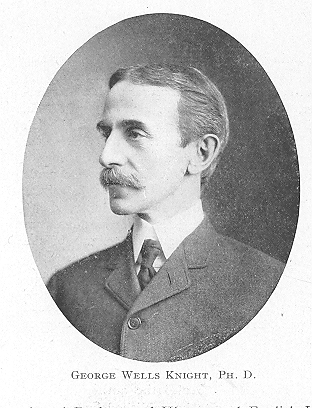
George Wells Knight, Ph. D., Chairman of the Administrative Board of the Graduate School, Ohio State University, at Columbus, Ohio ; Professor of History and Political Science and acting Dean ,of the
- 641 -
Law Department in the same University, was born on the 25th of June, 1858, at Ann Arbor, Michigan. He is of New York and New England parentage, and through his mother 'is a lineal descendant of William' Bradford, second Governor of the Plymouth colony. Dr. Knight was educated in the public schools of Ann Arbor, graduating from the High School in 1874, after which he entered Michigan. University at his home city; taking a classical course and graduating from that institution in 1878. He then Jar . one year studied law at the University. The following two years he was Principal of the High School at Lansing, Michigan. Having had from his youth a special fondness for history and political science, he returned to Ann Arbor and continued his studies in those lines at the University, receiving the degree of Doctor of Philosophy in 1884. After teaching history for a year in Ann Arbor, Dr. Knight was elected Professor of History and English Liferature in the Ohio State University at Columbus, and in 1887, by a re-arrangement of the teaching force, became Professor of History and Political Science in the same institution. He then went abroad, and in .the years of 1889-1890 took a special course of studies at the Universities of Halle, Berlin and Freiberg. Since 1898 Dr. Knight has occupied the Chair of American History, Political Science and Law. In 1885 he published, through the American Historical. Association, a work on "The History and Management of Land Grants for Education in the Northwest Territory." In 1887 he was made managing editor of the Ohio Archaeological and Historical Ouarterly the official publication of the State Historical Society, which position he has held for a number of years. After the death of Mr. William F: Hunter, in 1903. Dr. Knight became acting Dean of the Law Department of the O. S. U. In 1882. Dr. Knight was married to Miss Marietta A. Barnes, of Lansing, a graduate of Vassar College.

George Beecher Kauffman,
Professor of Pharmacy, and Dean of the College of Pharmacy, of the Ohio State University, at Columbus, Ohio, was born on the 19th of September, 1854, at Lancaster, Ohio. Both parents of Mr. Kauffman were natives of this country. his father, George Kauffman,- 642 -
being born in Maryland, and his mother, Henrietta Parnel Beecher; Connecticut. Receiving his early education in the common schools of the district in which he was brought up, he later entered the Ohio Wesleyan University at Delaware, Ohio, from which celebrated institution he graduated in 1875, with the degree of B. Sc: He also holds the degree of Pharm. D. At the age of thirty-one years Mr. Kauffman became connected With the Ohio State University in the capacities above mentioned. For many years has been closely identified with the wholesale and retail drug husiness,of Columbus, and at the present writing he is General Manager and director of the .Kauffman-Lattimer Company, one of the largest drug firms in the State. He also is interested in other industrial. enterprises, and is Vice President of The Pioneer Stove Company, as well as The Lattimer-Williams Stove Company. On the 5th of September; 1877; Dr. Kauffman was united in. marriage to Miss Eunice Hughes. Five children. are the result of this union, as follows: Margaret Glenn, Henrietta Christine, Myros Beecher, George Hughes and Linns Lee Kauffman. In .political belief, Dr. Kauffman is a staunch Republican. He occupies a pretty. residence on the State University grounds, and while not engaged in his professional capacity in the University, can be found at his private office in the building of the Kauffman-Lattimer Company, located on the corner of Front and Chestnut Streets, Columbus, Ohio.. He and his family attend the Methodist King Avenue Church in his.home city.
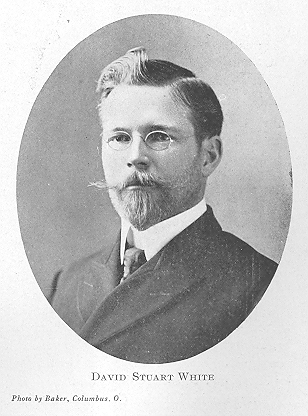
David Stuart White, Dean of the College of Veterinary Medicine of the Ohio State University, at Columbus, Ohio, since 1895, is a native of Staten Island, New York, at which place he was- born on the 28th of September, 1869. He is of Scotch-Irish ancestry, and the son of William Henry White, a retired merchant, born in Louisiana, and Catherine. Ann Elliott, a native of New York. The grandfather of Dr. White was a New Englander. In the public and private schools of New York he received his education, after which he attended the Ohio State University, graduating with the class of 1890, receiving the degree of D.V.S., He then went abroad and became a student in the Royal Veterinary Schools at Hanover and Berlin, remaining there during the years of 1890 ann 1891. At the Imperial Veterinary Institute at Vienna he was a student in 1892, and in 1893 he attended the Royal Veterinary College of Dresden. His course of foreign study occupied a period of three years, at the termination of which time he returned to America and became assistant in Veterinary. Medicine in the Ohio State University. This position he held from 1893 to 1895, when he was elevated to the Deanship of the Veterinary College of the same University. Dr. White has written several monographs, and is, the translator of a work on veterinary medicine. In 1898 Dr. White was appointed by Governor Bushnell Secretary of the State Board of Veterinary Examiners. He was elected in 1903 President
- 643 -
of the Council of Marble Cliff, of which body he had served as a Trustee previously. He is a leading Mason, and:was a member of the old Fourteenth Ohio Regiment, 0. N. G. In 1896 Dr.. White was united in marriage to Miss Nellie Smith, of Marietta, Ohio. By this union he is the father of one daughter. The position occupied by Dr. White is an evidence of . his deep learning - and broad experience in veterinary medicine, in which science he is considered an authority of National reputation. His residence is located on West Fifth Avenue, outside of the city limits of Columbus, Ohio.
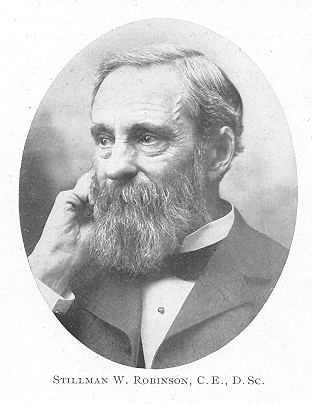
Stillman W. Robinson, C. E., D. Sc., Professor Emeritus in Mechanical Engineering in the Ohio State University, was born on a farm in Reading, Vermont, in 1838. From the earliest age when a child begins to notice construction he was interested in mechanical appliances, thus giving evidence of the natural trencl of his mind, and soon he began the work of construction, making little waterwheels, which were put in motion in the water guzzles. After he had attained the age of eight years he had not the privilege of attending the district schools except during the three months of winter, when his labors were riot needed in clearing and developing the fields. He had no time to devote to the mechanical pursuits which he so much enjoyed, except the few moments which he could gain by running ahead of the workmen going to dinner. Thus he managed to have a brief space for shop work, which was a source of far greater interest to him than the raising of crops.' When fifteen years of age he made a violin, which was prized far above most other musical instruments of the kind for energy and quality of tone. His sixteenth year was devoted to the operation of a sawmill, the erection of a furniture factory and grist-mill. Although he worked hard, his labor was lightened by the delight which he took in it, the opposite to his experience in the farm work.
At the end of that year Professor Robinson entered upon a four years' apprenticeship to the machinist's trade, and that time was pleasantly and profitably passed. Instead of beginning, work at his trade, however, he began to supplement his meager education, acquired in early youth, by subsequent study, meeting the expenses of his school courses by occasional machine job work.
In 1860 he left the Green Mountain State with a capital of eight dollars and stencil tools, and by cutting stencils in the towns along the way, increased his capital to fifty dollars, with which to take up his studies at the State University. In Ann Arbor, by making stethoscopes and by graduating thermometer scales, he managed to meet his board bills and other living expenses up to the time of his graduation from the University, in 1863, with the degree of Civil Engineer.
- 644 -
On leaving the University he was made assistant engineer in the United States Lake Survey, acting in that capacity from 1863 until 1866. In the latter year he became a teacher in mechanical and civil :engineering lines, being employed as instructor in engineering in the University of Michigan in 1866 and 1867, after which he was assistant in the same institution in mining engineering and geodesy from 1867 until 1870. His next position was that of professor of mechanical engineering and physics in the University of Illinois from 1870 until 1878, and in the last mentioned year he was Dean of the College of Engineering in that institution.
From 1878 until 1881 he was Professor of Mechanical Engineering and Physics in the Ohio State University, and from 1881 until 1895 Professor of Mechanical Engineering in the same institution, and then resigned in order to serve as inventor and mechanical engineer, notably for the Wire Grip and McKay Shoe Machinery Companies. His first invention was a thermometer graduating machine, made while in college. Various other inventions.have yielded more than forty patents, several being for shoe manufacturing machines. On several of these machines awards and medals were granted by expositions, including three by the Centennial and one by the Columbian Exposition.
In 1896 the degree of Doctor of Science was conferred upon him by the Ohio State University, and in 1899 he was elected to his present position of Professor Emeritus in Mechanical Engineering. In connection with his other work, Professor Robinson was State Inspector of Railroads and Bridges from 188o until 1884; Was consulting engineer to the Santa Fe Railroad from 1887 until 1890, and consulting engineer of the Lick Telescope and mountings in 1887. He is a member of the American Society of Civil Engineers, Amer: ican Society of Mechanical Engineers, Society of Naval Architects and Marine Engineers, a Fellow of the American Association for the Advancement of Science, and Society for the Promotion of Engineering Education.
He has been a frequent contributor to scientific literature, his writings being of great value. He is the author of The Principles of Mechanism," a college text book ; four of Van Nostrand's Science Series, namely : No. 8, Compound Steam Engines ; Part II in Analytical and Graphic Treatment, published in 1884; No. 24, Teeth of Gear Wheels, and Robinson's Templet Odontograph, issued in 1876; No. 59, Railroad Economics, published in 1882; No. 6o, Strength of Wrought Iron Bridge Members ; also numerous monographs, including- measurement of gas wells, railroad laboratories, car brakes, vibration of bridges, car couplers, flow of water in rivers, and numerous articles in connection with reports of railroad - inspection to societies of membership, and engineering magazines.
Professor Robinson has been twice married. In 1863 he wedded Miss M. E. Holden, who died in 1885, and in 1888 he was united in marriage to Miss M. Haines. Their home is located at No. 1353 Highland Street, Columbus, Ohio.

Herbert Osborn, Professor of Zoology and Entomology, Ohio State University, Director of the Lake Laboratory, was born in a frontier home in Lafayette Township, Walworth County, Wisconsin, on, the 19th of March, 1856. His parents were both from Massachusetts ; both had reached Wisconsin in early days, and they were married and located in Walworth County on the 1st of May, 1844.
His father, Charles. Paine Osborn was born at Hadley, Massachusetts, on the 22d of November, 1817, and died at Fairfax, Iowa, on the 27th of April, 1891. His grandfather, Alpheus Osborn, was a soldier in the War of 1812 ; a great-grandfather, Roswell Paine, and a great-great-grandfather, James Chamberlain, were in the American Revolution, the former
- 645 -
as a Captain. His grandmother on the father's side descended from Stephen Paine, who settled in New England in 1638, coming from Norfolk, England. His mother, Harriet Newell Marsh, was born at Montague, Massachusetts, on the 28th of August, 1823, and still lives. Her ancestors trace back through six generations of Marshes to John Marsh, of Hartford, Connecticut, whose wife was a daughter of Governor John Webster. A great-great-grandfather, Enos Marsh, was a Revolu tionary soldier.
The family moved from Wisconsin to Iowa in 1863, locating at Fairfax, Linn County, which was at that time practically unbroken prairie. The country settled rapidly, how ever, and schools fully up to the average of the time were soon available.
The subject of our sketch, after the usual common school work, began study at Iowa College, Grinnell, but work here was interrupted by sickness and lack of funds, and his next college work was taken up at the Iowa Agricultural College at Ames in 1876, where he completed a four years' course, graduating in November, 1879, with the degree of B. Sc. Funds for the college course were secured by teaching country schools and by work during the college terms. On graduating, he was elected to a position as assistant in zoology and entomology, but continued his studies, receiving the degree of Master of Science on completion of the graduate course of study. Though holding the position at Ames continuously from the day of graduation till 1898, he was able, by taking advantage of long winter vacations, to pursue studies further. Thus he spent the winter of 1881-1882 in the. Museum of Comparative Zoology at Harvard, the winter of .1883-1884 in the College of Physicians and Surgeons at Des Moines, giving also a course of lectures on Parasites and Parasitic Diseases of Man ; the winter of 1885-1886 in Washington, working in the Division of Entomology and the National Museum.
From assistant in zoology and entomology he was gradually advanced to the head of the department, and given charge also of the work in geology. In 1890 the duties of entomologist of. the Iowa Experiment Station were added, while during the years 1885 to 1894 he was special agent for Iowa of the Division of Entomology of the United States Department of Agriculture. In 1893 he had charge of the exhibit in entomology from the experiment stations of the United States in the Columbian Exposition at Chicago. A law was enacted by the Iowa. Legislature in the winter of 1898, under which the entomologist of the- experiment station was made ex-officio State Entomologist, and Professor Osborn filled this position from the time the law took effect till his departure for his present position in Ohio. Dr. Kellicott died in April, 1898. The position was offered to Professor Osborn in June. .He assumed the duties of his present position in September of 1898.
During his connection with. the Department of Agriculture, Professor Osborn mad,' numerous trips for the purpose of investigating insect outbreaks in Iowa, Wisconsin,
- 646 -
Missouri and Kansas, and his published reports include life history studies upon a number Of important pests. In the winter of 1891-1892 he took an extended trip through Mexico, collecting insects at various points as far south as the Isthmus of Tehuantepec. The results were the discovery of a number of new species and the gathering of material that has added to the known distribution of a number of other forms. A trip to Europe was made in the winter of 1894-1895, primarily for study at the Naples Zoological Station, where for three months he occupied the Smithsonian Table. Visits in London, Paris, Berlin, Leipsic, INIunich, Florence, Rome and other cities were utilized in studying the laboratories and museums of some of the best-known centers of zoological study.
While his efforts have been primarily in the field of the teacher, not a year since his first country school in 1875 having paSsed without its regular grind of school work, an active interest has been kept up in other lines, and investigations and experiments in the field of entomology have been numerous. Many new species of insects have been discovered and described, mainly in the groups of Mallophage and Hemipters, and numerous additions to the knowledge of life-histories and methods of controlling injurious species. He has con.- tributed many short articles on injurious insects to leading agricultural papers, among them the "Iowa Homestead," "Prairie Farmer," "Orange Judd Farmer," "American Agriculturist," and "The Ohio Farmer." His scientific papers have appeared in various technical journals and the proceedings of scientific societies. An extended report on the "Insects Affecting Domestic Animals," over three hundred pages and numerous original illustrations, was published by the Department of Agriculture in 1896, one on the "Hessian Fly in the United States" in 1898. The articles on "Parasitic Insects" and "Poisonous Insects" in Woods' "Reference Hand Book of the Medical Sciences" (1903), are from his pen.
He was elected a member of the American Association for the Advancement.of Science in 1883, made a Fellow in 1884, and a member of the Societe Entomologique de France in 1888. He was President of the Iowa Academy of Science in 1887-1888, and for a number of years its Secretary-Treasurer and editor of its proceedings. He was President of the Entomological Club of the American Association for the Advancement of Science in 1891, during the Washington meeting, and of the Association of Economic Entomologists for the Boston meeting in 1898. He is also a member of the Biological Society of Washington, the Entomological Society of Washington, the American Entomological Society of Philadelphia, and of the National Geographic Society ; Treasurer of the Ohio Academy of Sciences, member of the Society for the Promotion of Agricultural Science, and member for Ohio of the AdVisory Board of Entomologists for the National Mosquito Extermination Society.
He was married on the 19th of January, 1883, to Alice Isadore Sayles, of Manchester, Iowa, a graduate of the Iowa Agricultural College in 1881. They have a family of five children._
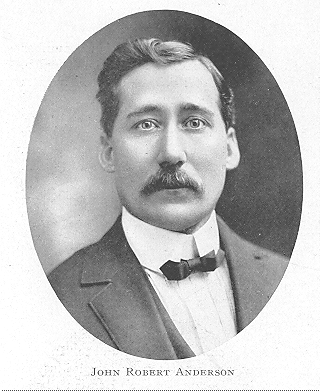
John Robert Anderson, Superintendent of the Public Schools in Bellaire, Ohio, a conscientious and capable educator, was born on the 31st of July, 1863, at Bellaire. He is the son of a coal miner, Isaac C. Anderson, a native of Pennsylvania, and M. J. Lashley Anderson, a native of this State. The father's family were early settlers of Pennsylvania, and were of English origin, while the mother was of German parentage. Mr. Anderson was educated at the Bellaire common schools, and graduated from the High School of that city in 1882. Later he attended, Bethany College, West Virginia, from which institution he received the honorary degree of A.M. At the early age of nineteen years Mr. Anderson became a teacher in the Belmont
- 647 -
County schools. He subsequently held the position of Principal of the Second Ward school at Bellaire, served for ten years in the Central School in the same capacity, and as teacher in the Bellaire High School. Since 1897 Mr. Anderson has had charge of. the Superintendency of the public schools of his home city, and, thanks to his ability, energy and conscientiousness, the schools of Bellaire have reached a high standard. Mr. Anderson has devoted a great deal of his time to technical studies, the result of which culminated in the invention of a thermo signal, a heat regulator of great merit, which will be introduced in in the new High School building at Bellaire. He is proprietor of the flourishing enterprise, the Bellaire Foundry and Machine Company, located in the city mentions. For many years he has been a member of the Teachers' Examiners of his city. Socially, Mr. Andersen is a Mason, K. of P., and a member of the I. O. O. F. In 1887 he became the husband of Mollie B. Ward, and by that marriage is the father of eight children, five of whom are boys. The Anderson family attends the Christian Church of Bellaire, in which Mr.Anderson is a Deacon and a member of the Official Board.
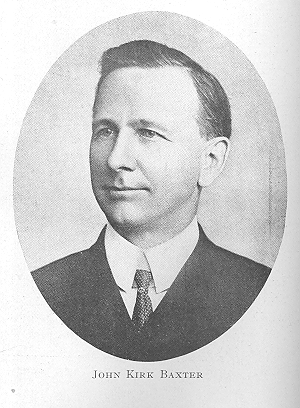
John Kirk Baxter, Superintendent of the Public Schools of Mt. Vernon, Ohio, was born at West Liberty, Iowa. He is the son of William A. Baxter, a Miller, and Mrs. Hannah (Ball) Baxter, both of whom were natives, of Ohio. Mr. Baxter is of Irish descent on his father's side, his great- grandfather emigrating from Ireland when seventeen years of age. His mother's people were of Scotch extraction. At the early age of six months Mr. Baxter's parents brought him to East Rochester, Columbiana County, Ohio, where he obtained the first rudiments of an education in the district schools. Later he attended Malvern. High School and graduated from Hiram College in 1890. When sixteen years of age he commenced to earn his own living, working laboriously in his father's mill, and afterwards as a teacher in the country schools, thereby obtaining the, necessary funds to pay for his subsequent education. For five years he was Superintendent of the
- 648 -
schools of Malvern, at the expiration of which time he entered Hiram College, remaining there for three years. After leaving college, Mr. Baxter accepted the position of. Principal of the Mt. Vernon High School, holding the same for a continuous-period of eight years. In 1898, when Mr. Bonebrake retired from the Superintendency of the schools of Mt. Vernon to enter on his first term of Commissioner of the Schools of Ohio, to which honOrable position he was elected the previous year, Mr. Baxter was unanimously, elected by the School Board of that city to fill the vacant position. Mr. Baxter is an educator of high rank, and a fluent speaker. He has done a great deal of Institute work in different parts of the State, and is the holder of a life High School certificate, given to him in 1893. In politics, Mr. Baxter is a faithful Republican. He is Trustee of the .Public Library of Mt. Vernon, a member of the .different branches of Masonry and a K. T., and belongs to the National Teachers' Association, of which he was a director in 1902 ; and a member of the State Teachers' Association. Miss Flora Ross, an accomplished lady of Carroll County, became his bride in 1892. Mr. and Mrs. Baxter are members of the Christian Church Of Mt. Vernon.

A. D. Beechy, Superintendent of the Public Schools of Norwalk, Ohio, an educator of recognized ability, was born on the 11th of April, 1852, in Berlin, Holmes County; Ohio;where his father, David Beechy, operated a farm. His, mother's Maiden name was Judith (Yoder), and she, like his father, was a native of Ohio. The boyhood days of Mr. Beechy were spent on the farm,. where he assisted his father in obtaining a livelihood. He was educated in the common schools of Holmes County, at Haysville Acadeniy, Ashland County ; at Mt. Union College, Alliance, and in a post-graduate course at Wooster. He holds the degrees of A.B. and A.M. from Mt. Union College and the title of Doctor of Philosophy from the. Wooster University. When eighteen years of age he began teaching, following his profession in country, village and town school, at Elmore, Ohio; Louisville, Ohio, and Berlin, Ohio, saving his earnings to pay for his further education. During the years of 1889-1891 Mr. Beechy was Principal of the Norwalk High Sehool; since that latter period he has filled the position of Superintendent of Schools of Norwalk. Mr. Beechy is an affable, large-hearted and highly educated gentleman, and has a circle of appreciative friends throughout. the State, especially in his home cities, where his long residence has year by year added to his popularity. He stands high in his profession, and is looked upon by the public, as well as those over whom. he occupies a supervisory position, as a man of exceptional ability and stability of character. In political life, Mr. Beechy is a staunch adherent of the Republican belief, but has never held any political office. He is a member Of the Masonic: fraternity and the I. O. O. F. In 1882 he led to the altar Miss Theresa Baumann, an accomplished young lady. One daughter is the issue of this union.
- 649 -
Cell 1-